
The Ghost Skeljungur and Bóla in Bólugil - Folklore from North Iceland

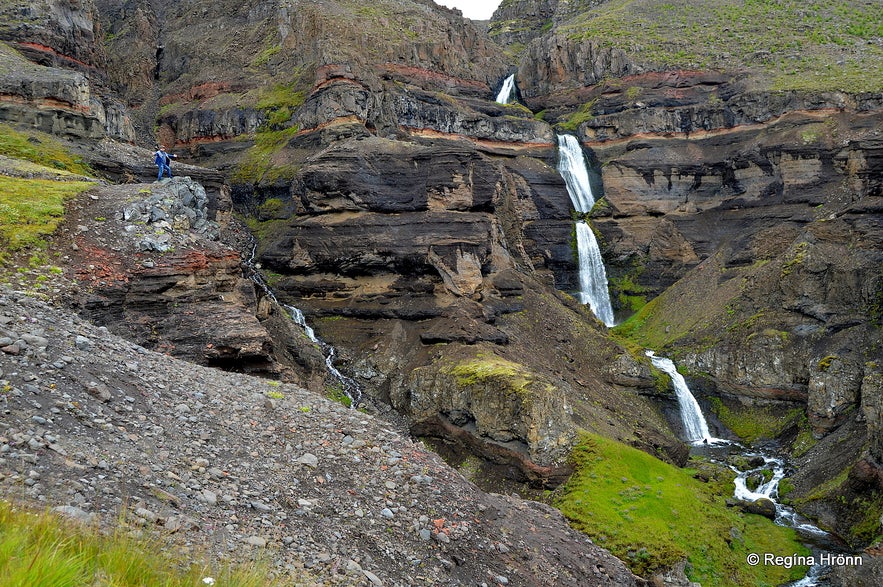
And also why a peculiar rock close by is called Skeljungssteinn rock. These stories, which are supposed to have taken place around the settlement of Iceland, are told in Icelandic folklore.
The stories are brutal and I never pass this area without thinking about the terrible fate of Bóla and Skeljungur.
Opening photo: Bólugil gorge

By Bólugil gorge
Let's start by hearing the story of Bóla from Silfrastaðir farm, and her fight with the violent Skeljungur, the shepherd at Silfrastaðir farm.
This story is told in Þjóðsögur Jóns Árnasonar - the Collection of Folklore by Jón Árnason and is called Þáttur af Grími Skeljungsbana. I translated it into English and recapitulated it:
"With Þorgrímur at Silfrastaðir farm was a Flemish bondwoman called Bóla. She was malicious and had an awful temperament and most people thought that she was very difficult to deal with.
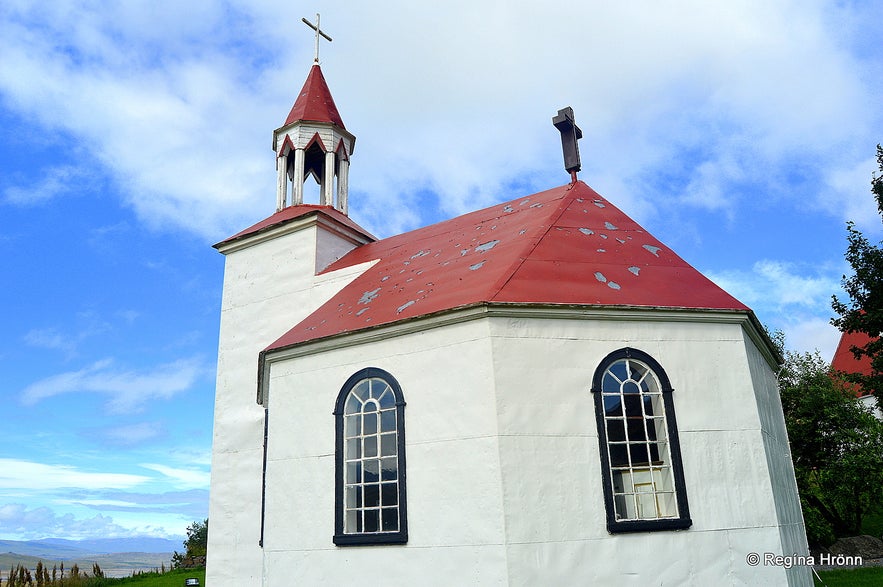 Silfrastaðakirkja church at Silfrastaðir
Silfrastaðakirkja church at Silfrastaðir
The shepherd Skeljungur, who also worked at the farm, and Bóla didn't get along at all (they seem to have been of a similar temperament and extremely irritated) and the farmer often had to settle fights between them.
Finally, Bóla ran away from home in an angry fit, and people thought that she might have found a place to stay in the gorge close to Silfrastaðir, but this gorge divides Blönduhlíð from Norðurárdalur valley.
A small river runs in the gorge and 3 relatively tall waterfalls cascade in the upper part of the gorge. It is difficult to reach the top 2 waterfalls and impossible to reach the uppermost waterfall.
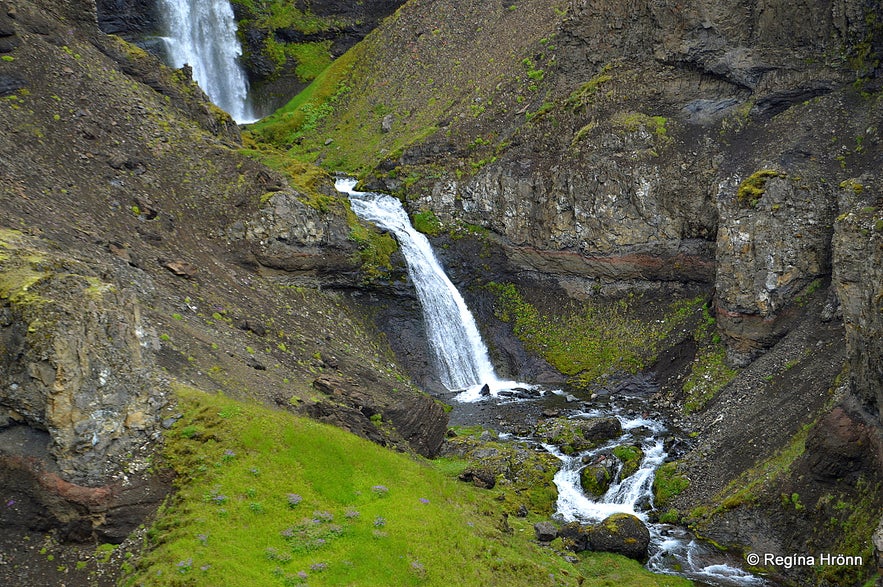 Bólugil gorge and a couple of the waterfalls
Bólugil gorge and a couple of the waterfalls
People gathered that Bóla lived in a cave by that waterfall. And she often came down into the valley and plundered and stole livestock from the farmers.
The gorge has ever since been named after Bóla - Bólugil gorge - and the abandoned farm to the north of the gorge is called Bóla.
Early one winter, five oldish sheep disappeared from the farmer Þorgrímur, which Skeljungur was guarding - and people blamed Bóla.
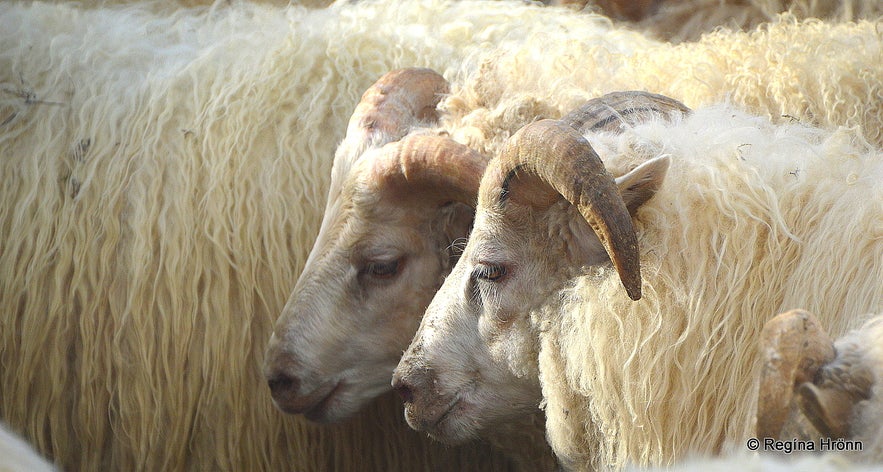 Icelandic sheep
Icelandic sheep
The shepherd Skeljungur was livid and wanted to find out the truth about the disappearing sheep. The farmer stopped him and told him that nothing good would come from harming Bóla.
The following autumn eight sheep disappeared from the farmer who yet again stopped Skeljungur from doing anything about it. The same happened the following autumn, but this time around 10 sheep disappeared.
Now Skeljungur was out of his mind with rage and told the farmer that he could not be stopped searching for the sheep at Bóla's.
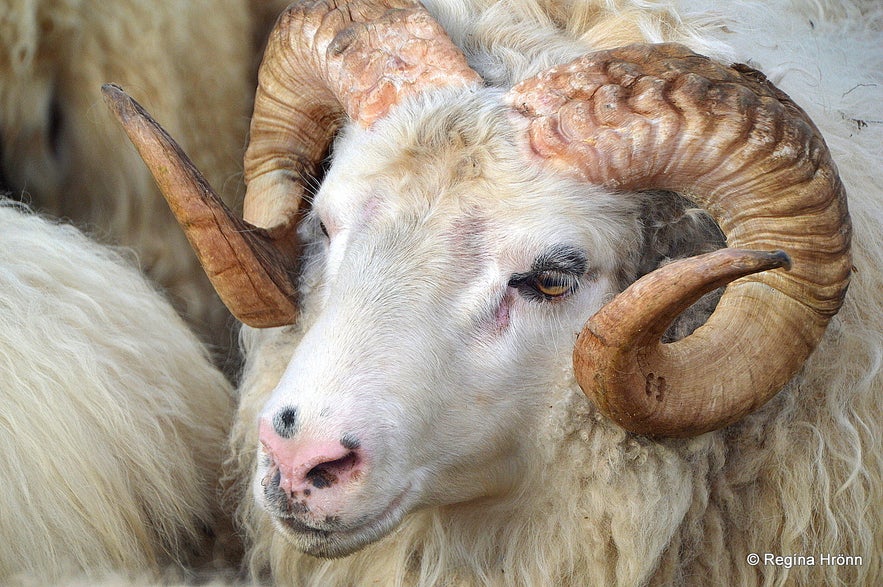 Icelandic sheep
Icelandic sheep
Skeljungur went berserk and ran into the gorge and managed to get under the uppermost waterfall (this has since then been called Skeljunghshlaup).
Nobody knows what happened when he met Bóla, some say that after a long and brutal fight, Skeljungur drowned Bóla in a pool beneath the waterfall.
At least nobody has seen Bóla since that time.
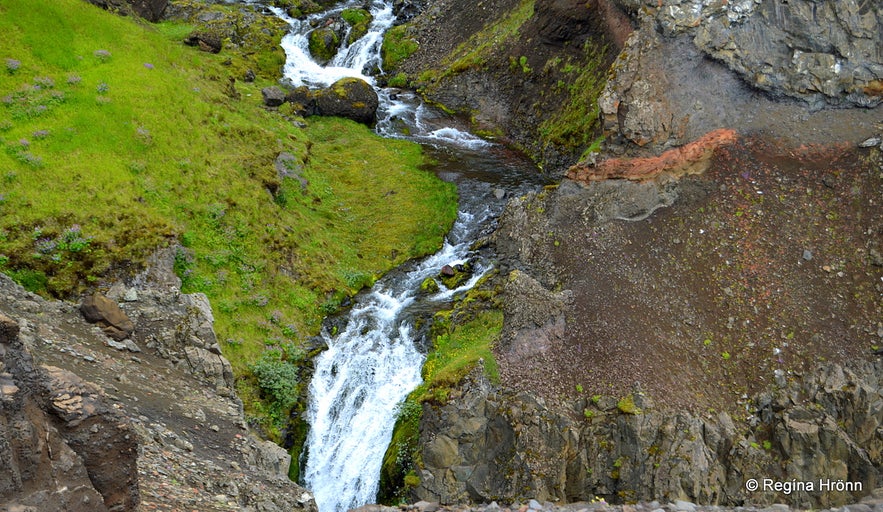 Looking into Bólugil gorge
Looking into Bólugil gorge
Skeljungur went back home and said that no more sheep would disappear for a while.
Since that time Skeljungur became even worse to handle than before, but he stayed true to the farmer.
(Translated into English and recapitulated from Þjóðsögur Jóns Árnasonar - the Collection of Folklore by Jón Árnason called Þáttur af Grími Skeljungsbana).
 I didn't go further up than this, but my husband went out on a sill to have a closer look
I didn't go further up than this, but my husband went out on a sill to have a closer look
This was the story of Bóla and Bólugil gorge. I don't know if the waterfalls have a name, but I have heard them referred to as Bólufoss waterfall.
They are not marked as such though on the map of Landmælingar Íslands - the National Land Survey of Iceland.
Bólu-Hjálmar
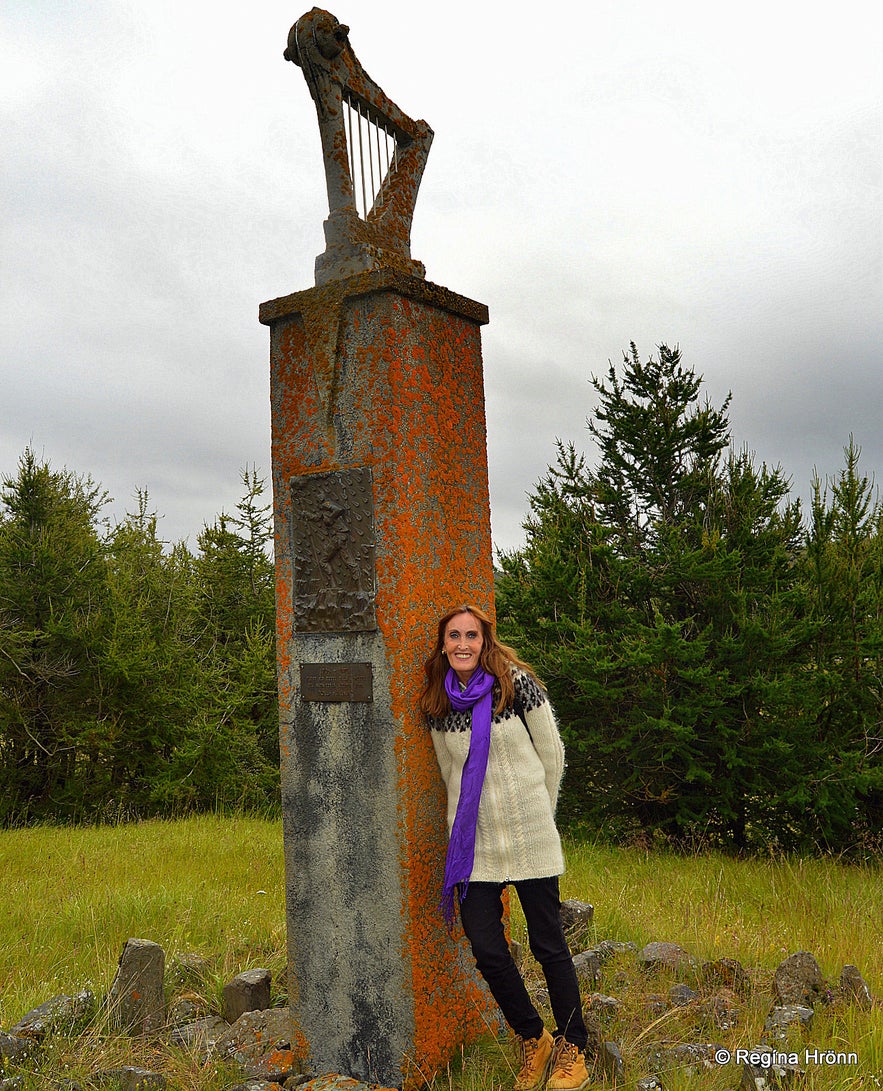 By the memorial for Bólu-Hjálmar at Bóla
By the memorial for Bólu-Hjálmar at Bóla
Later on, one of our poets Hjálmar Jónsson (1796-1875) lived at Bóla and was nicknamed Bólu-Hjálmar. Hjálmar was the one who registered the folklore Þáttur af Grími Skeljungsbana in 1859.
When we kids learned old Icelandic poems at school we always found it both strange and funny that this poet was named Bólu-Hjálmar.
And I remember that we were a bit scared when we were kids, of the sketch below of Bólu-Hjálmar, which was in Skólaljóð - our book of school poems. The sketch was made by Ríkarður Jónsson around 1920 after a description of several people who knew Hjálmar.
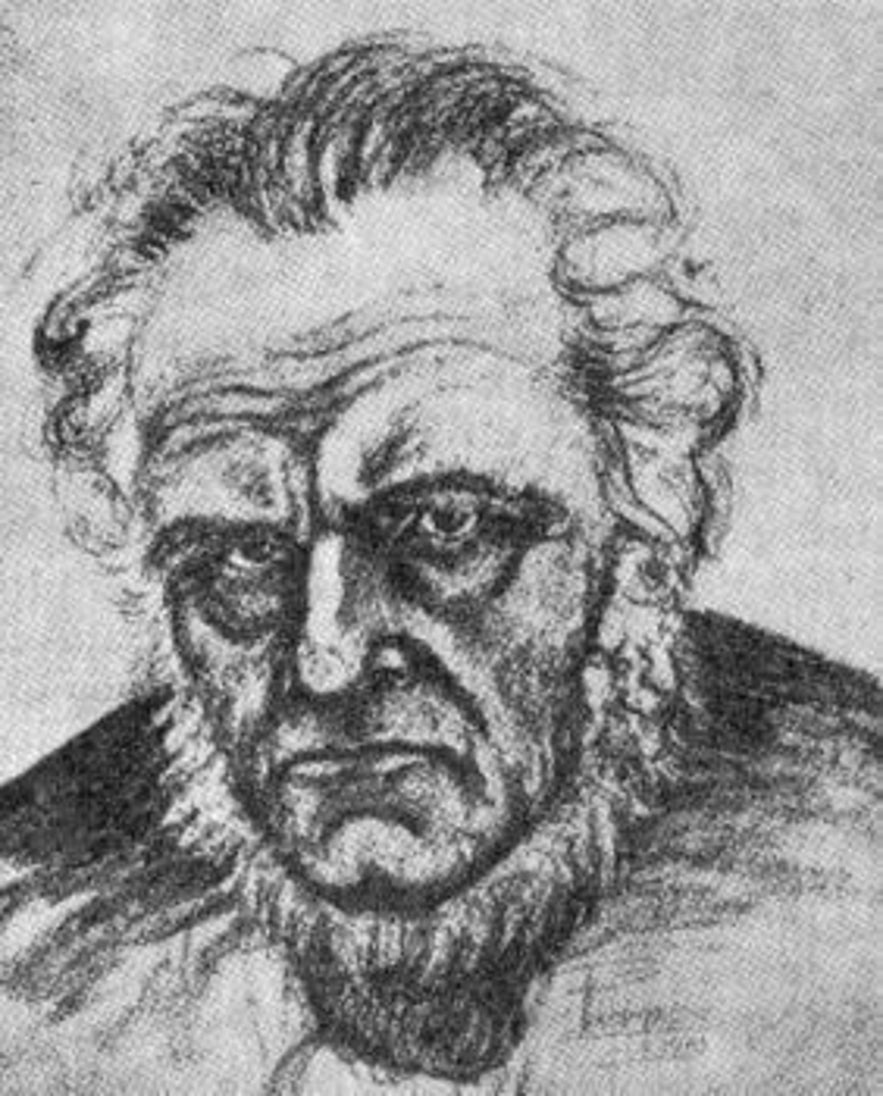 A sketch of Bólu-Hjálmar by Ríkarður Jónsson - photo from the Internet
A sketch of Bólu-Hjálmar by Ríkarður Jónsson - photo from the Internet
The farm Bóla was called Bólstaðargerði earlier on, but Bólu-Hjálmar when taking up residence at the farm renamed it Bóla.
He lived at Bóla for 10 years, but prior to him moving to the farm, it had been deserted.
Bólu-Hjálmar was poor and lived a difficult life. He was suspected of stealing sheep much like Bóla herself, and his farm was ransacked, but he was not found guilty.
It must have been very difficult for Bólu-Hjálmar to be accused of this crime, especially after having been driven away from Nýibær in Austurdalur by his violent neighbours. When I read his story, I felt deeply for him, as he lived such a difficult life.
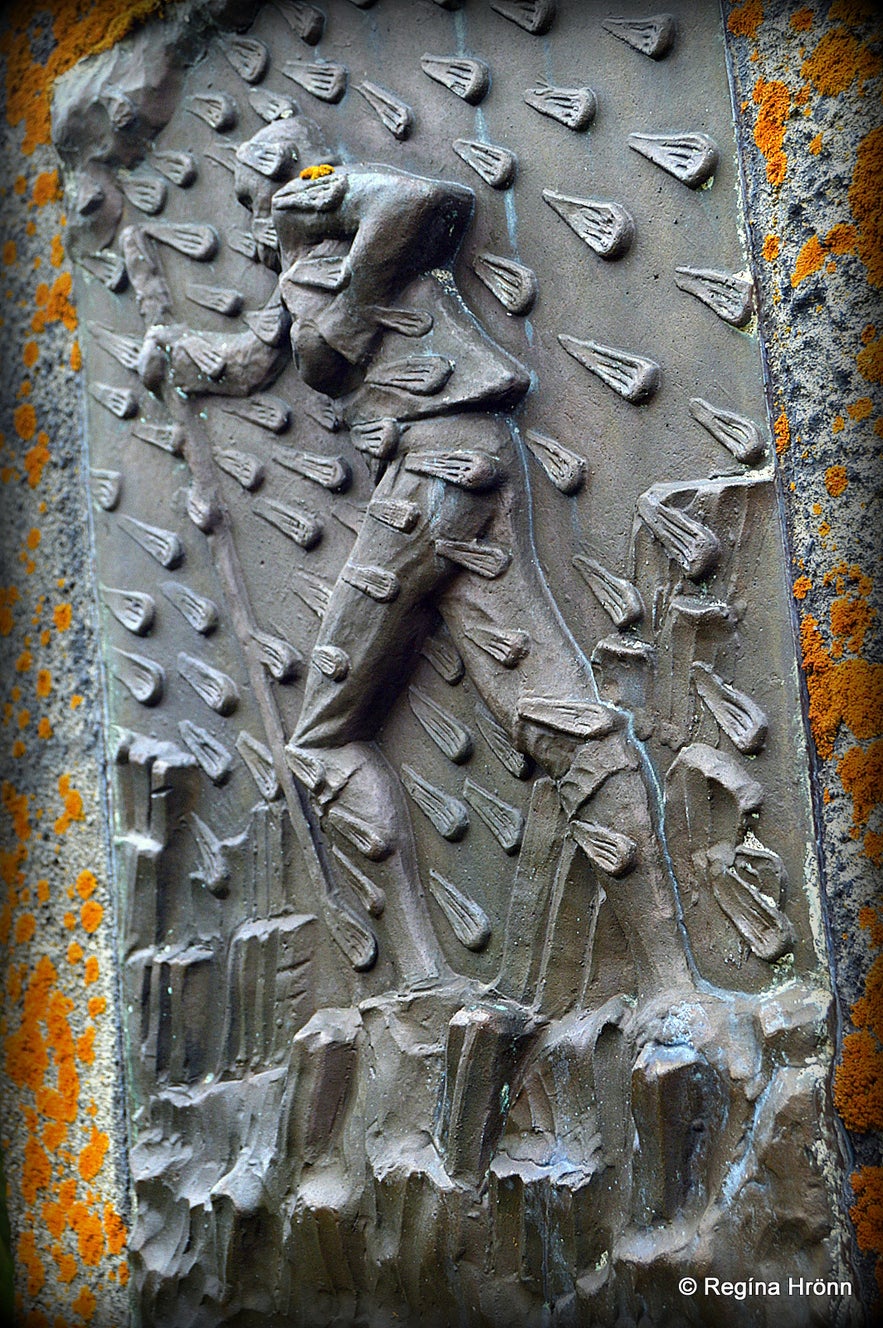 The low relief on the memorial for Bólu-Hjálmar at Bóla
The low relief on the memorial for Bólu-Hjálmar at Bóla
A year later Hjálmar moved away from Bóla.
What we have to take into account is that stealing sheep was one of the most serious crimes in Iceland so being under suspicion of having committed this crime would have been very hard for Bólu-Hjálmar and his wife.
My favourite poem by Bólu-Hjálmar is:
"Víða til þess vott eg fann,
þótt venjist oftar hinu,
að guð á margan gimstein þann
sem glóir í mannsorpinu"
Hjálmar was laid to rest in the graveyard at Miklibær and you will find a large memorial stone on his grave.
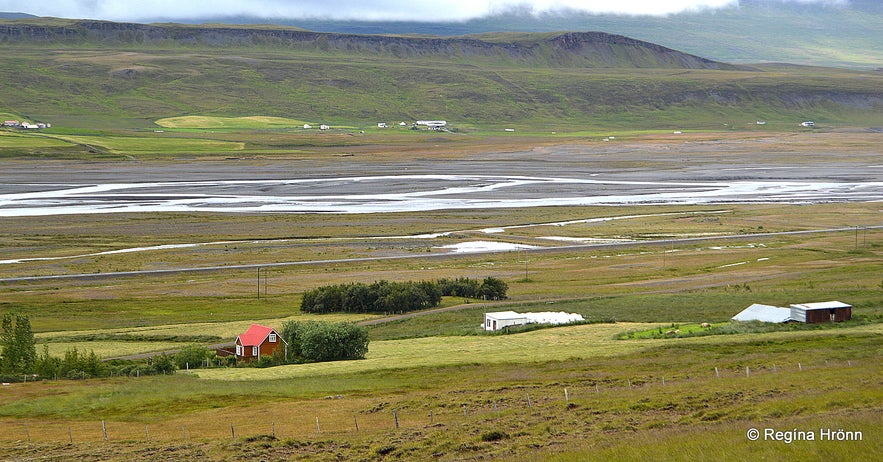 The view from our hike to Bólugil gorge
The view from our hike to Bólugil gorge
The Bólugil gorge and the waterfalls are easily spotted from ring road 1.
You can park your car and hike by the gorge Bólugil up to the waterfalls.
The river falls some 140 meters down the gorge and creates a row of 7 cascading waterfalls, which are on the National Heritage Register. This is an easy hike, just don't go there in the wintertime.
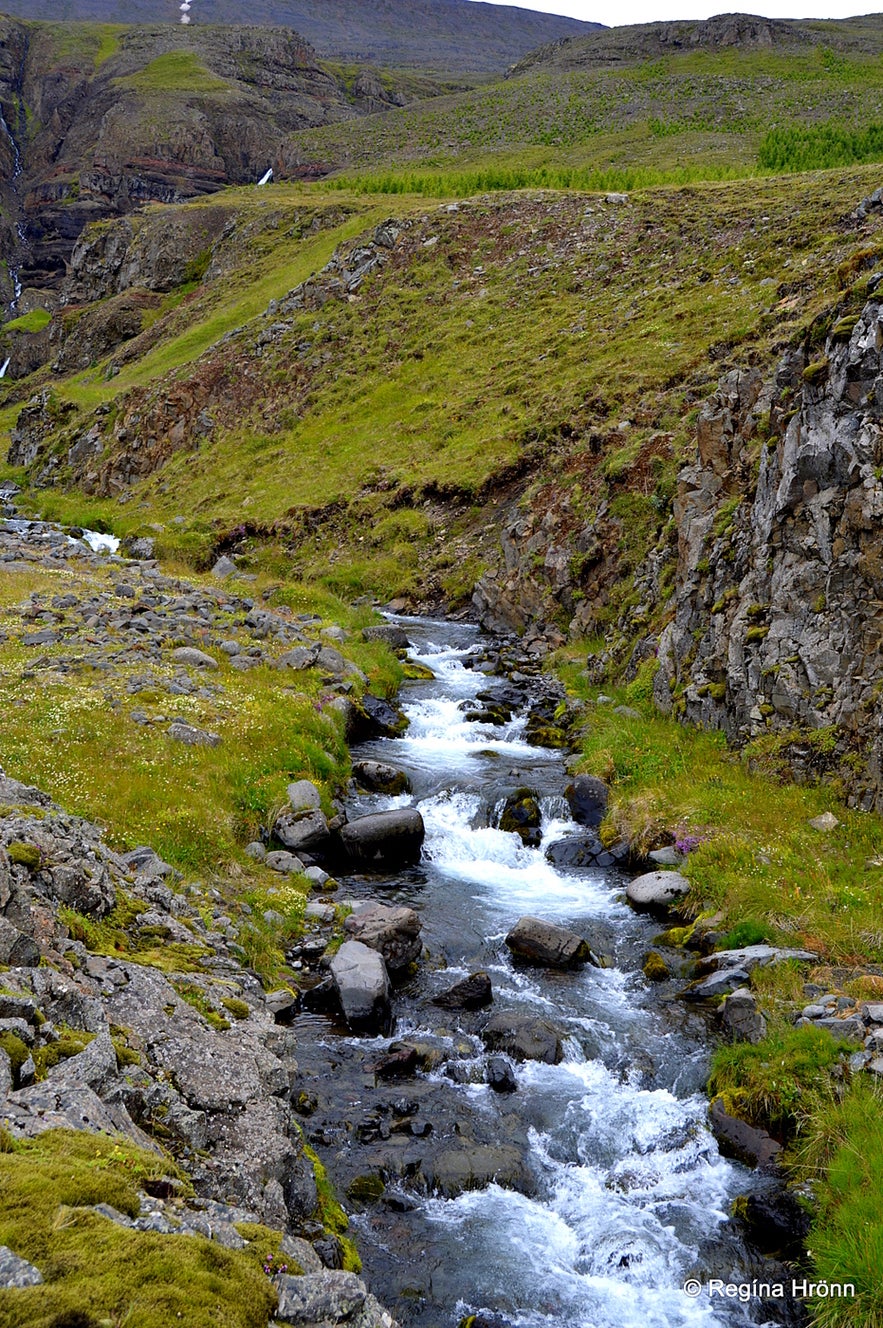 Bóluá river in Bólugil gorge
Bóluá river in Bólugil gorge
Now, let's go to Silfrastaðir, which is very close to Bóla, where Bóla and Skeljungur lived, and see what has happened there. And find out what happened to Skeljungur after he killed Bóla.
Silfrastaðir and Silfrastaðakirkja church
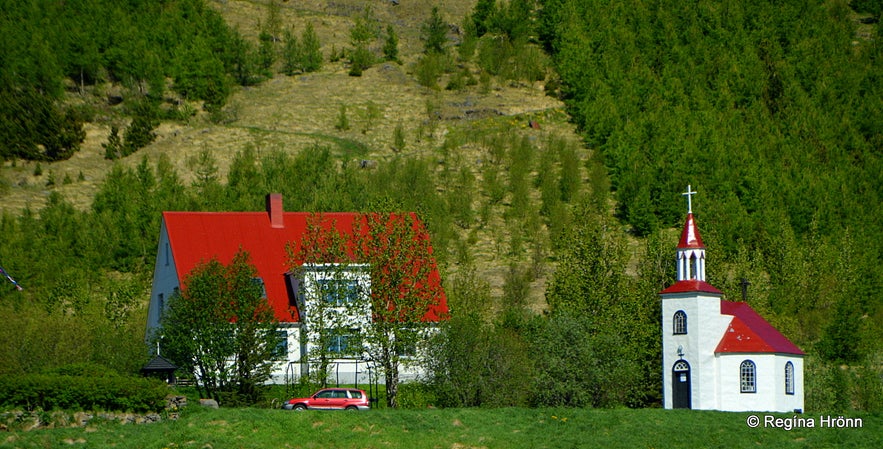 Silfrastaðir farm and Silfrastaðakirkja church
Silfrastaðir farm and Silfrastaðakirkja church
Silfrastaðir is mentioned in Landnáma - the Book of Settlements in chapter 62. Landnáma tells us that the settler Þorbrandur örrek settled land from Bólstaðará river, the whole of Silfrastaðahlíð and Norðurárdalur valley and lived at Þorbrandsstaðir farm.
There he built a huge kitchen and everybody who travelled through this area should carry all their baggage through the kitchen and everybody was welcome to help themselves to food from the kitchen.
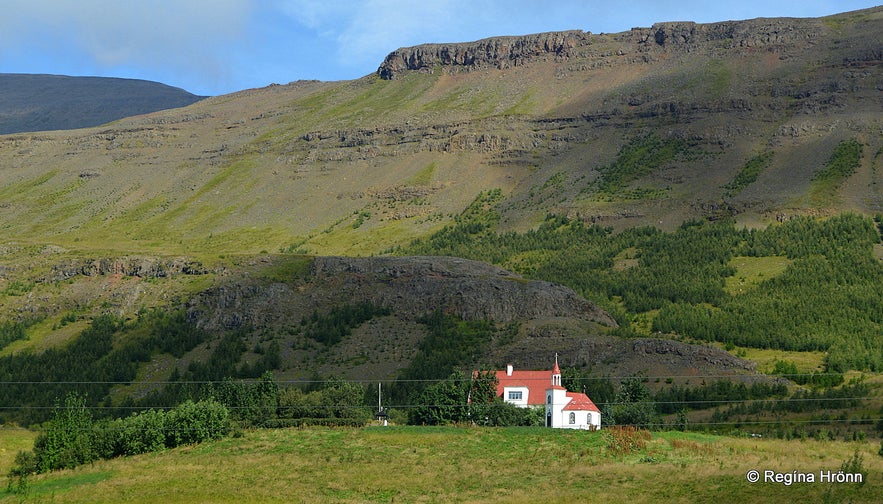 Silfrastaðir and Silfrastaðakirkja church - isn't it pretty?
Silfrastaðir and Silfrastaðakirkja church - isn't it pretty?
Silfrastaðir was a manor and a church site and it is mentioned in Sturlunga several times, f.ex. when Kolbeinn and Órækja in the year 1234 stayed at Silfrastaðir with 600 men.
And Þórður kakali stayed at Silfrastaðir with 500 men back in 1246 before going to the Haugsnesbardagi battle, and there is an interesting account in Sturlunga about what happened that night.
See also my travel-blog: The Horrific Viking Battles in Skagafjörður, North Iceland
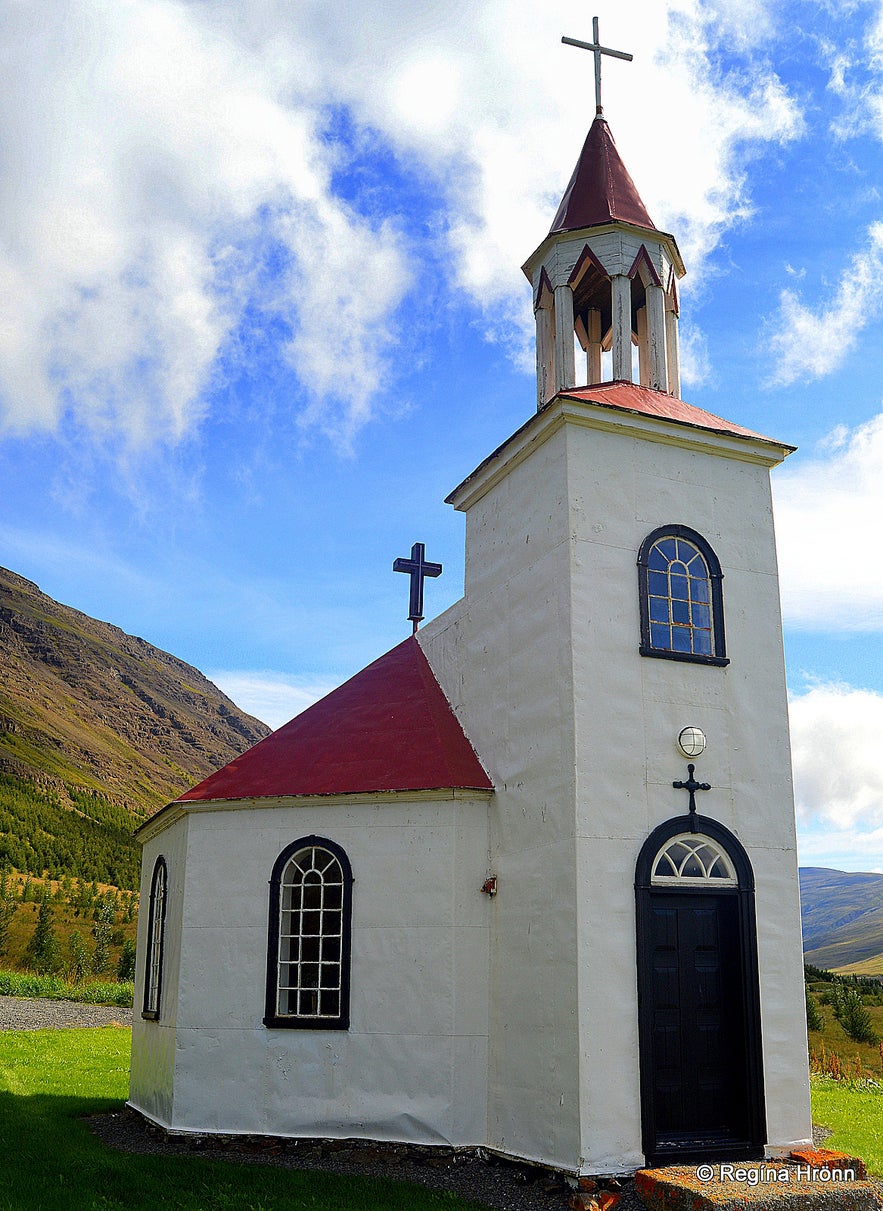 The octagonal Silfrastaðakirkja church
The octagonal Silfrastaðakirkja church
Silfrastaðir farm stands on a hill and there is a beautiful little octagonal church, Silfrastaðakirkja, next to the farm. It was built in 1896, replacing a turf church from 1842.
A reconstruction of that old turf church at Silfrastaðir is now at Árbæjarsafn folk museum in Reykjavík.
When I pass by it I always think to myself that this must be one of the most beautiful church sites in Iceland. The church is under repair and the last time I saw it (in the summer of 2022) it was all wrapped up in Sauðárkrókur village.
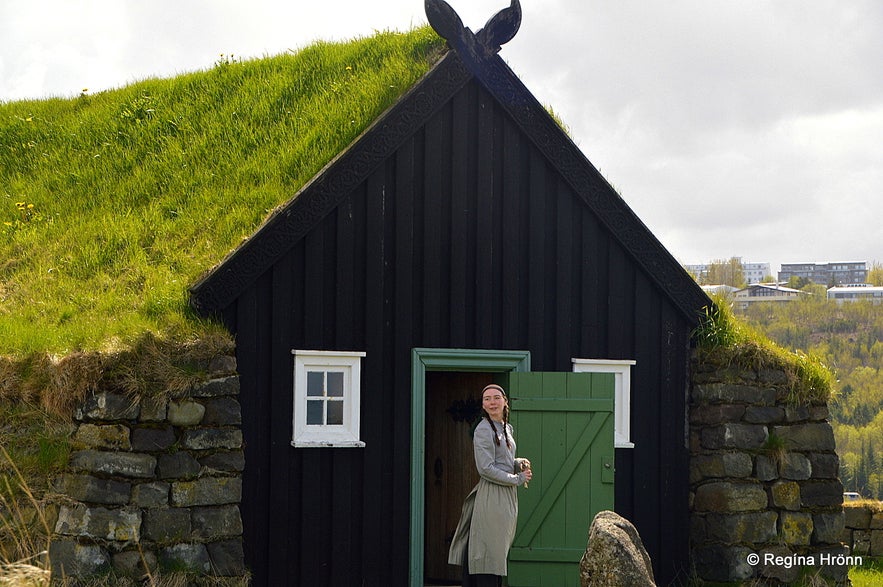 The reconstructed turf church at Árbæjarsafn museum in Reykjavík
The reconstructed turf church at Árbæjarsafn museum in Reykjavík
The main road passed by Silfrastaðir farm but was later moved further down to the river and now we drive by the glacial river Norðurá, which then joins Austari-Jökulsá and turns into Héraðsvötn along with Vestari-Jökulsá.
Now, let's hear the story about Skeljungur and how he became a ghost.
The shepherd and ghost Skeljungur at Silfrastaðir farm
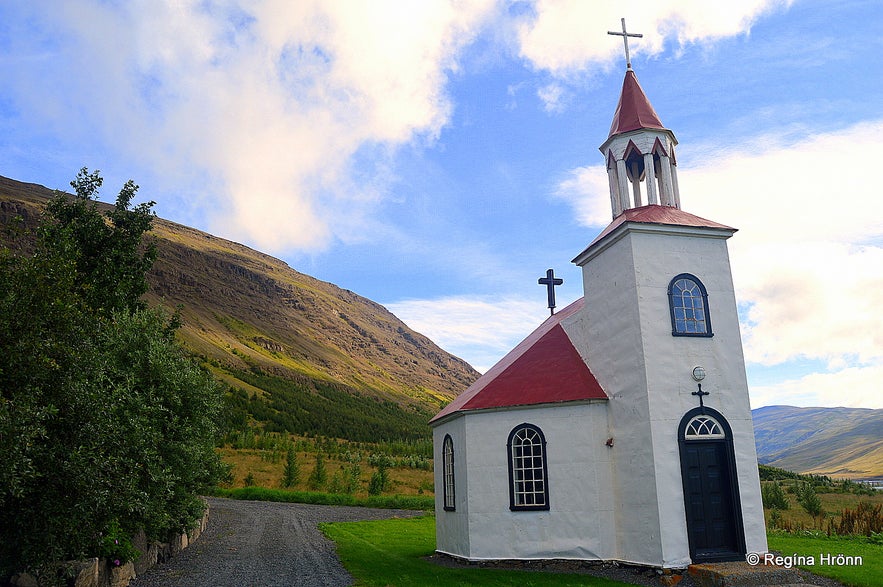 Silfrastaðakirkja church, the light was not favourable
Silfrastaðakirkja church, the light was not favourable
This story is told in a couple of folklore, but I will continue with the same story Þáttur af Grími-Skeljungsbana from Þjóðsögur Jóns Árnasonar - the Collection of Folklore by Jón Árnason.
It is a long story so I will retell the part of the story which tells us about Skeljungur.
The farmer of Silfrastaðir was Þorgrímur, the son-in-law of Þorbrandur, the one with the thoroughfare kitchen. He had a son named Grímur.
Norse merchants arrived by ship at Kolbeinsárós (now Kolkuós) and from them, Þorgrímur bought the slave Skeljungur.
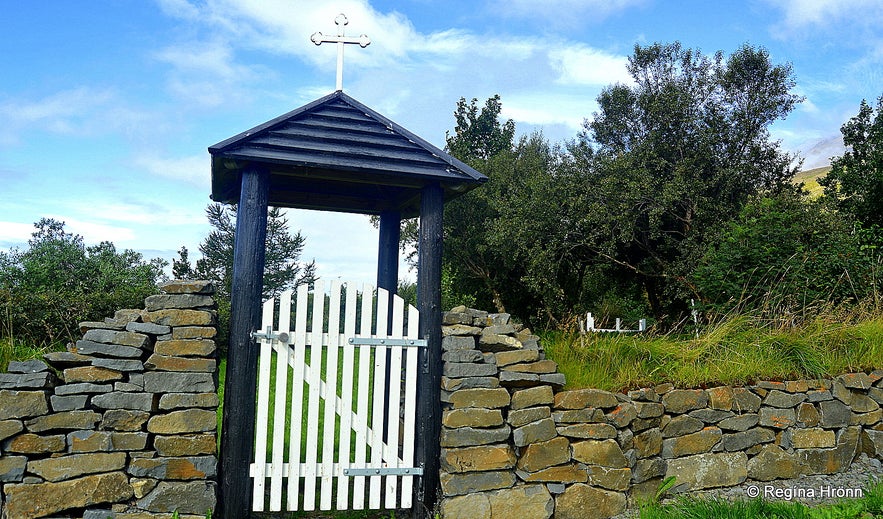 At Silfrastaðir
At Silfrastaðir
Skeljungur had a fierce temper and was difficult to handle, but had the strength of 2 men. He was loyal to the farmer and guarded his sheep. He didn't get along with the others at the farm and especially not Grímur.
This happened at the same time as the troll games at Hofmannaflöt, which Bárður Snæfellsás and Ármann in Mt. Ármannsfell were hosting.
All of Iceland's strongest men were invited to the games to find out who was the strongest man in Iceland as I told you about in a previous travel-blog: Ármann in Mt. Ármannsfell and the Troll Games on Hofmannaflöt Plains in South Iceland.
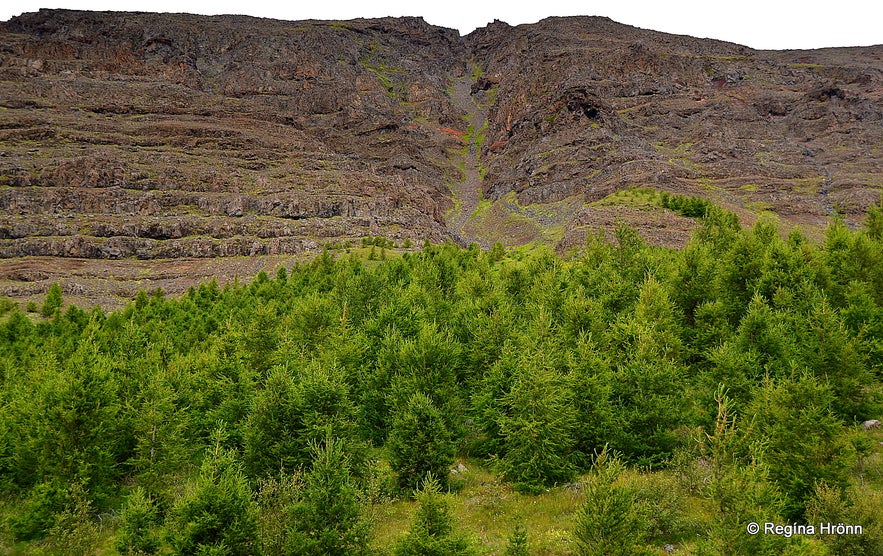 Mt. Silfrastaðafjall, Skeljungshellir cave is somewhere in the cliffs
Mt. Silfrastaðafjall, Skeljungshellir cave is somewhere in the cliffs
Lágálfur Lítildrósarson from Siglunes took part in the games. And as he walked back from the games late at night (a very long walk from the south) he passed Silfrastaðir and met Skeljungur.
Skeljungur introduced himself as the shepherd at Silfrastaðir farm and that he had just returned back from guarding the sheep.
Skeljungur wanted to wrestle with Lágálfur as he was cold and thought that wrestling would warm him up. Lágálfur answered that he had just come back from wrestling good and strong men and that Skeljungur looked like a villainous slave.
But he would humour him and wrestle with him, even though he was tired from this long walk.
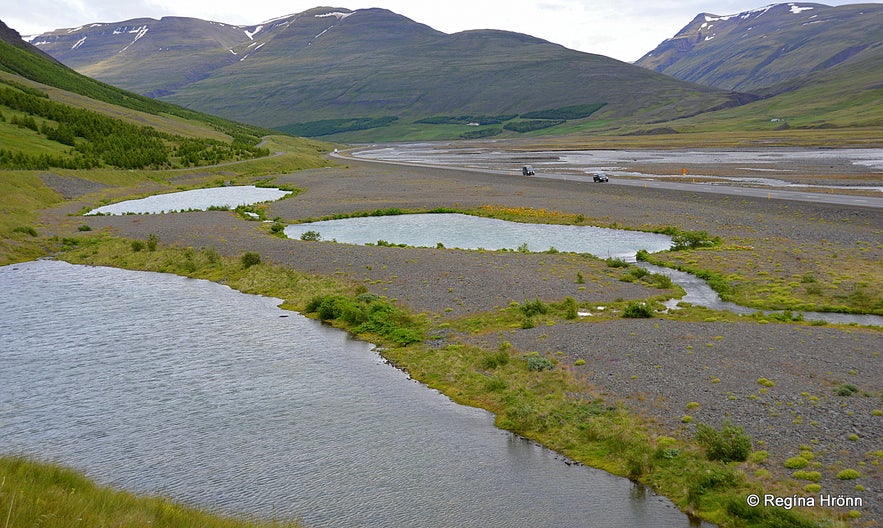 The view from Skeljungshöfði cape
The view from Skeljungshöfði cape
They wrestled for the longest time with great force, but in the end, Lágálfur was able to throw Skeljungur up in the air and he fell down so hard on the frozen, rocky ground, that both his thighbones broke - and both his arms were dislocated.
Lágálfur left him to die and alerted the people at Silfrastaðir of Skeljungur's death by reciting a verse through one of the windows.
The men at Silfrastaðir went to search for Skeljungur that night, but couldn't find him as it was already dark outside. They searched for him again the next morning, but couldn't find him.
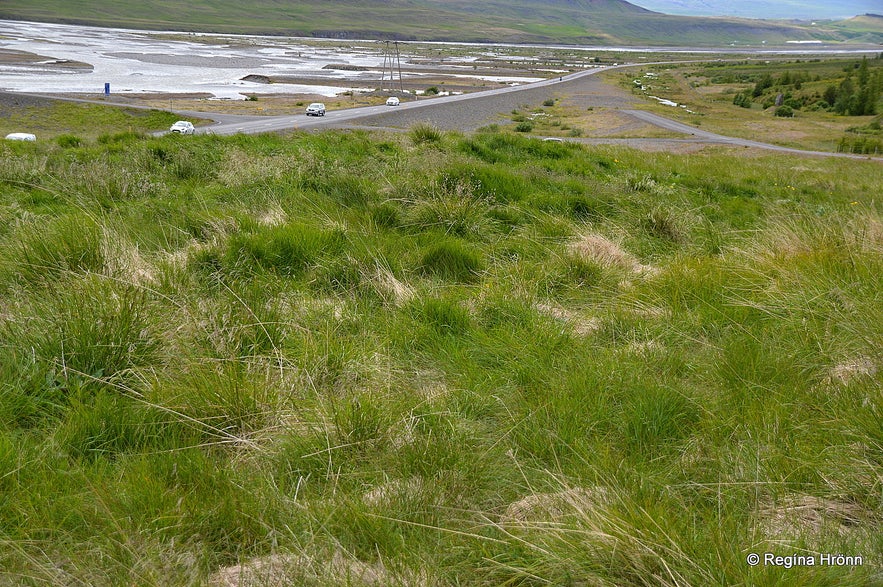 Ruins on Skeljungshöfði cape - see how close it is to ring-road 1
Ruins on Skeljungshöfði cape - see how close it is to ring-road 1
Skeljungur who had died from his wounds was not happy about this turn of events and returned as a ghost, and stayed in a cave called Skeljungshellir cave. He made passers-by lose their way and killed their cats and dogs.
On Christmas Eve one of the shepherds at Silfrastaðir farm didn't return back home and was found dead the next day close to Skeljungshellir cave.
The following Christmas exactly the same thing happened, and by now nobody wanted to work as a shepherd on the Silfrastaðir farm. On the 3rd Christmas after Skeljungur started hunting his neigbhours Grímur Þorgrímsson, who had been staying in Greenland, returned back home.
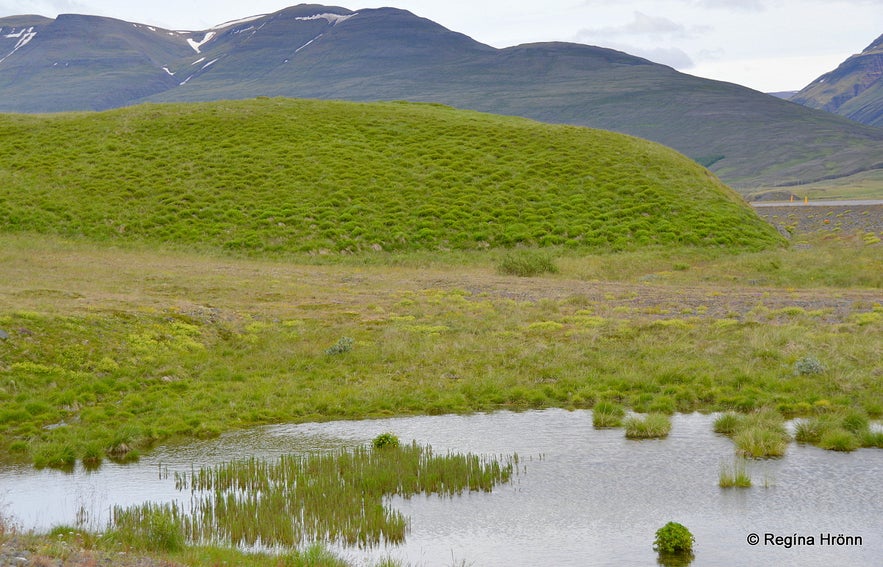 Skeljungshöfði cape in Norðurárdalur valley
Skeljungshöfði cape in Norðurárdalur valley
There is a long account in the story about how Grímur, upon returning back home, had a feeling that things were not right at home, and he rode so hard that 2 of his horses died. This was on Christmas Eve.
He was told that Skeljungur haunted the farm after dark and that nobody dared go outside after dark. And it was even worse now at Christmas time.
Grímur took the skin of a bull that had been slaughtered for Christmas and cut 3 thick straps from the skin.
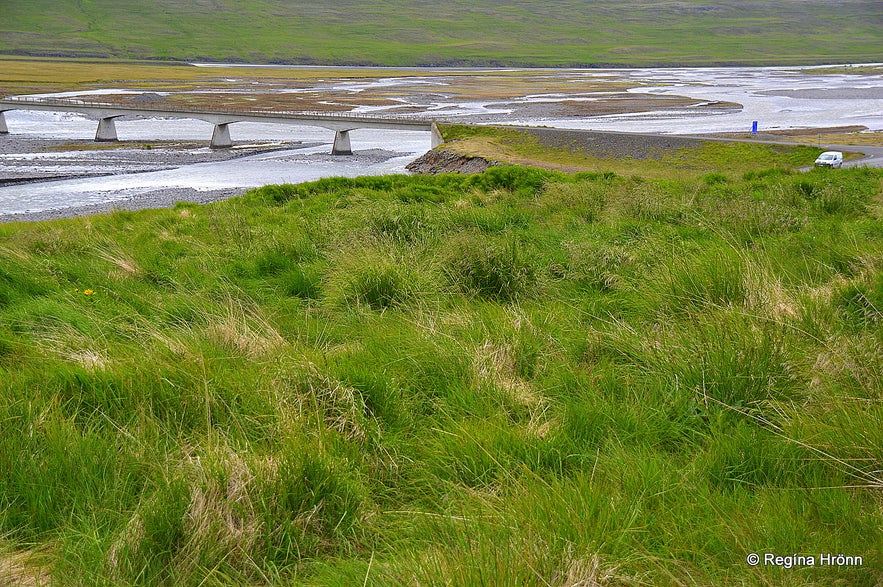 On top of Skeljungshöfði cape - the bridge leading to Kjálki
On top of Skeljungshöfði cape - the bridge leading to Kjálki
He ventured outside and walked to a hill where a large lone rock stood on top of the hill.
It looked like a ritualistic stone (blótsteinn), oblong and very wide at the bottom but thinner at the top.
He made 3 holes through the stone with his spear and tied the straps through the holes.
The people at the Silfrastaðir farm now celebrated Christmas and the return of Grímur, the son of the farmer.
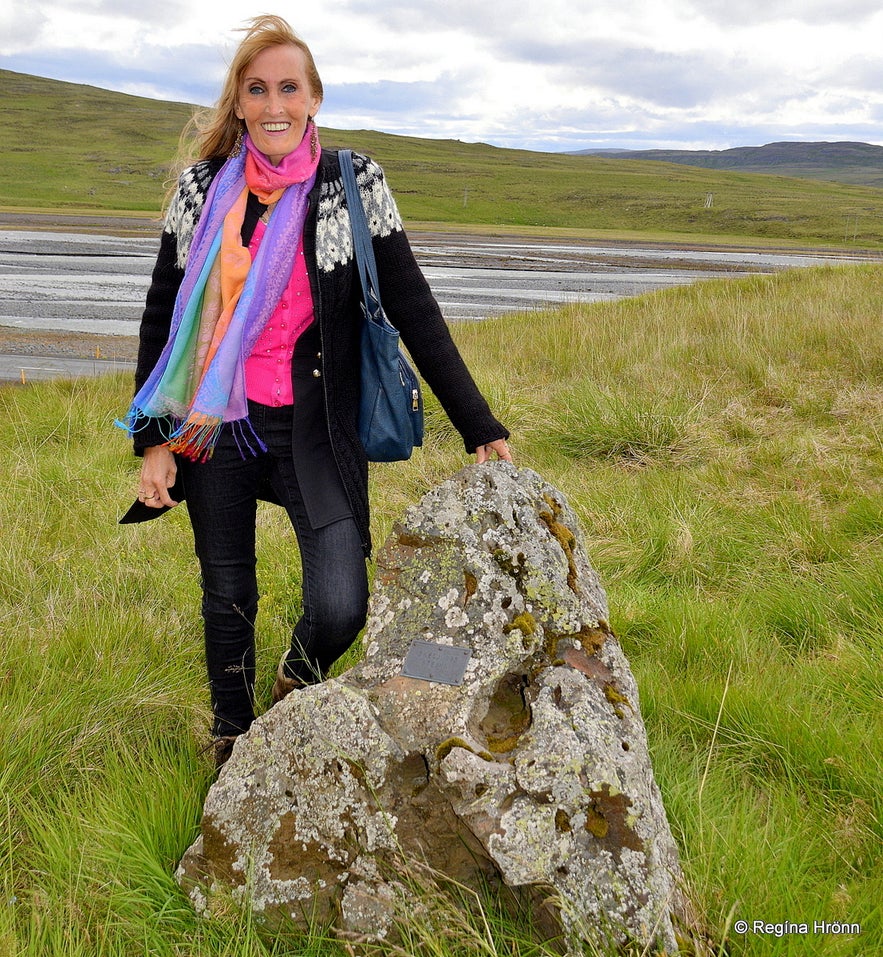 By Skeljungssteinn rock - it has sunk since the 9th-10th century
By Skeljungssteinn rock - it has sunk since the 9th-10th century
When they went to sleep Grímur slept by the door under the new bull skin. They woke abruptly to a loud commotion on the roof of the farm and became very afraid.
Skeljungur the ghost, knocked loudly on the front door and threw it up.
He spotted a newcomer and pulled on the skin that Grímur had been sleeping under. And now began a tug of war between those two.
Then Grímur lay on the skin and Skeljungur pulled him on the skin away from the farm, with Grímur putting up heavy resistance, and onto the hill with the lone rock.
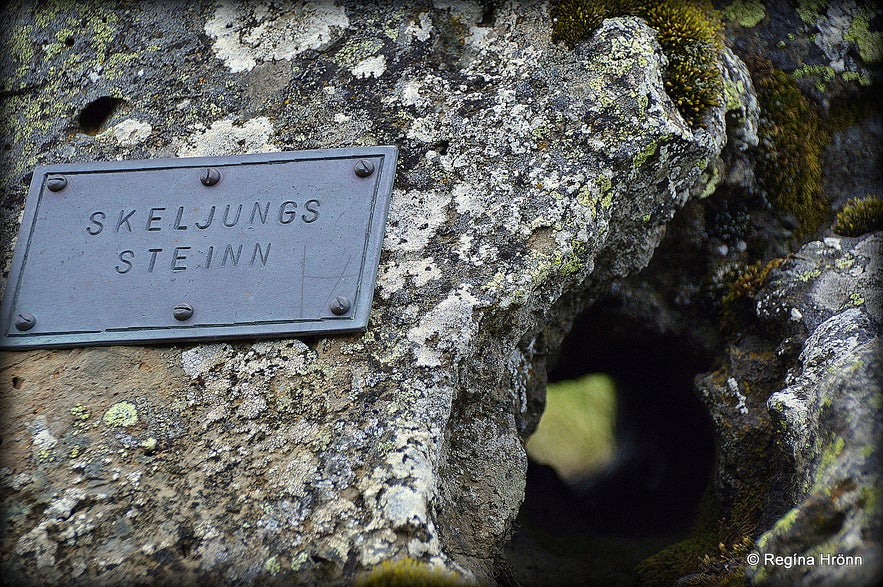 Skeljungssteinn rock
Skeljungssteinn rock
They fought with great force, but Grímur succeeded in getting Skeljungur close to the rock and tied him to the rock with the straps.
Grímur hurried back to Silfrastaðir to fetch some firewood and fire to burn the ghost. But upon his return, he saw that both the rock and the ghost were gone!
He gathered that the ghost was headed further into the valley - with the rock. Grímur spotted Skeljungur the ghost in the valley and he was dragging the rock with great effort.
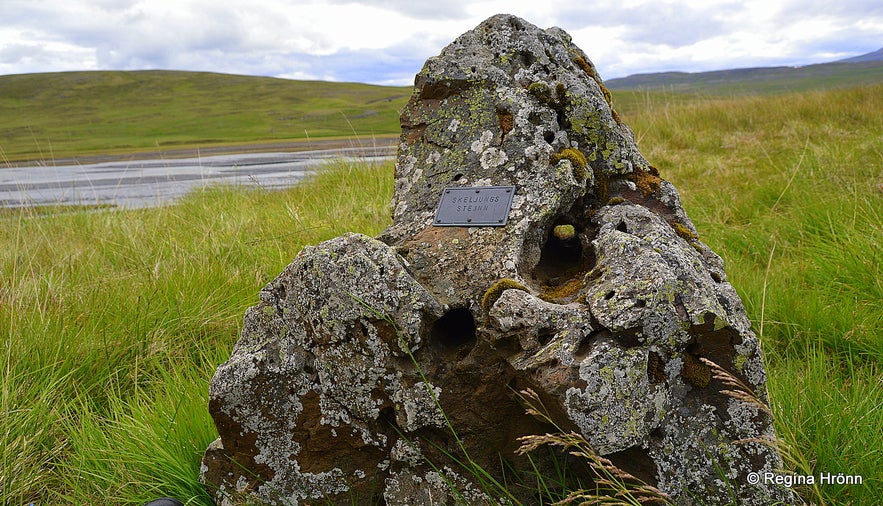 Skeljungssteinn rock with the 2 holes
Skeljungssteinn rock with the 2 holes
Grímur followed him until Skeljungur reached the hill that has since then been called Skeljungshöfði - the Cape of Skeljungur.
Grímur then chopped off Skeljungur's head and burnt the ghost to ashes - he then threw the ashes into the pond by the cape, called Silungapollur pond.
The rock is still on Skeljungshóll and 2 holes can be seen, but it is said that the 3rd hole is sunken into the ground.
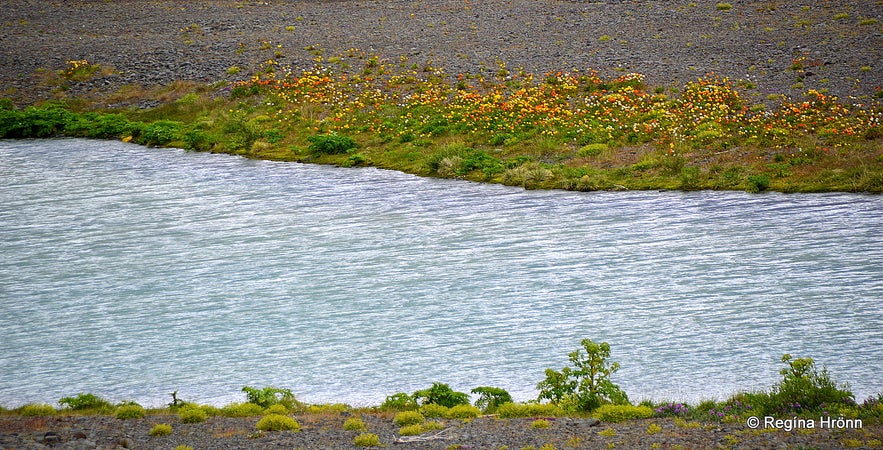 Ponds by Skeljungshöfði - the course of the river has changed since Skeljungur was here
Ponds by Skeljungshöfði - the course of the river has changed since Skeljungur was here
The part of the rock which is still above ground reaches the average man to his hip.
The holes look like they have been drilled with a gimlet and are so wide that it is possible to stick two fingers inside.
Another story tells us that Grímur threw the ashes of Skeljungur into the river Norðurá which runs by the cape and the valley.
(Translated into English from Þjóðsögur Jóns Árnasonar - the Collection of Folklore by Jón Árnason).
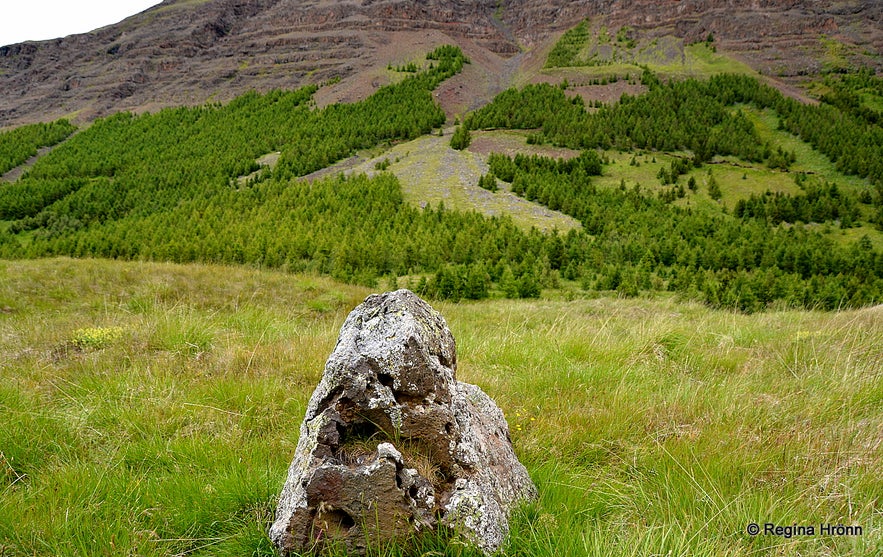 Skeljungssteinn rock and Mt. Silfrastaðafjall where the cave is somewhere to be found
Skeljungssteinn rock and Mt. Silfrastaðafjall where the cave is somewhere to be found
In the mountain above Skeljungshöfði, where Skeljungur was tied to the basalt rock, high up in the rocks is the cave where Skeljungur lived (after he became a ghost).
This is a horrible story, which I think about every time we go up north. Today we call this cape Skeljungshöfði cape and the rock, which is now preserved, is called Skeljungssteinn rock.
We found the Skeljungssteinn rock on Skeljungshöfði cape, after having searched for it for the longest time, as it is hidden away in the grass.
I had only seen one photo of the rock and it was difficult to see where exactly it was located from that one photo.
 Skeljungssteinn rock
Skeljungssteinn rock
We also found some turf farm ruins, but a farm was built on Skeljungshöfði cape, when I don't know, but Skeljungsskáli is mentioned in Sturlunga, when Eyjólfur ofsi Þorsteinsson and his men stopped here on their way to burn down Flugumýri back in 1253.
The holes in the Skeljungssteinn rock are 78 cm long (the lower one) and 1 meter long (the upper one) and approximately 8 cm in diameter, give or take a few cm.
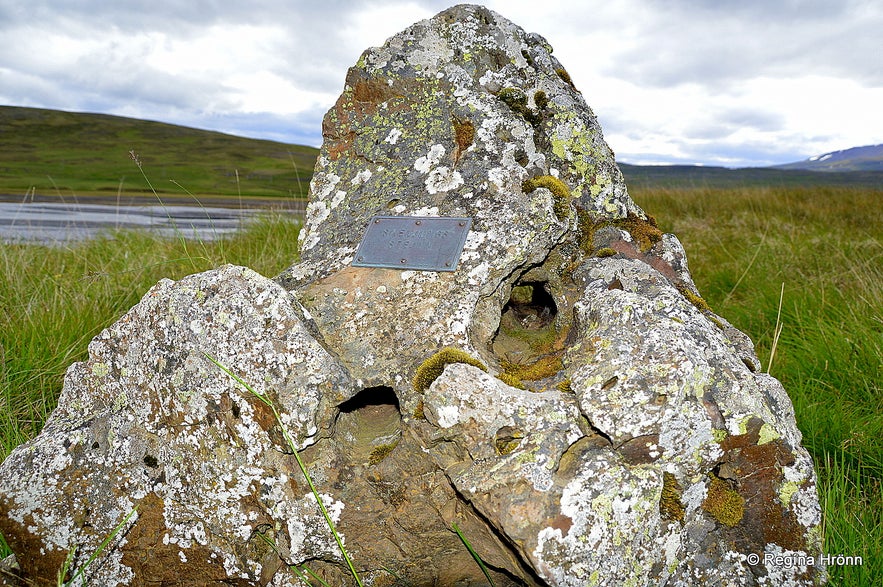 Skeljungssteinn all lit up by the flash for a closer look - it was getting very windy and dark
Skeljungssteinn all lit up by the flash for a closer look - it was getting very windy and dark
The geological explanation of the holes in the rock is very different from the folklore. Some 7-8 million years ago, thin-flowing lava reached an ancient forest and covered and burn the trees.
With time the burnt trees disappeared leaving only the holes behind. So the holes were created by fossilized logs. You can see such holes in the walls of Kotagil gorge close by.
But how come Skeljungssteinn rock stands alone on a cape?
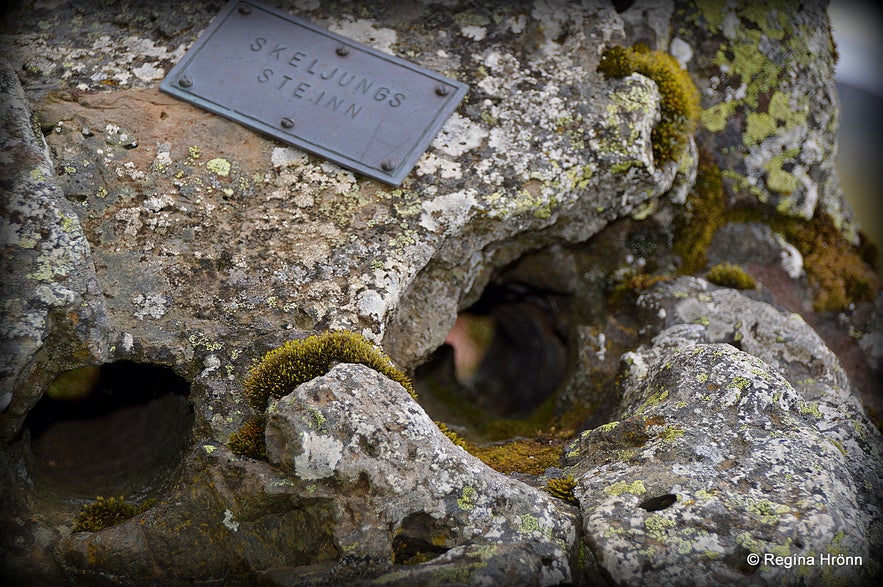 The big holes in Skeljungssteinn rock
The big holes in Skeljungssteinn rock
Kotagil gorge is by the other end of Mt. Silfrastaðafjall, and I have written another travel-blog about my exploration of the gorge.
In my travel-blog about a hike to the waterfall at the end of the gorge, you can read more about the geological explanation of the holes in the Skeljungssteinn rock: An interesting Hike into the craggy Kotagil Gorge in North Iceland.
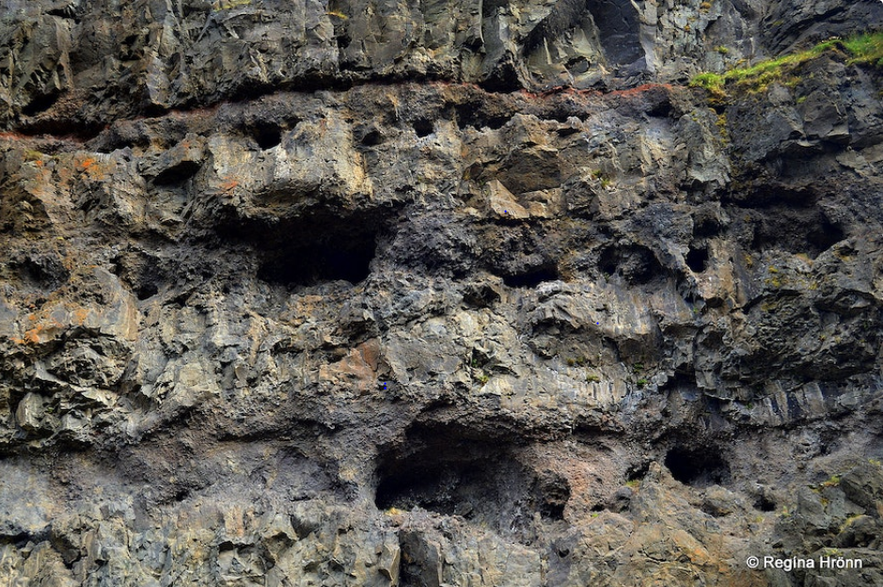
And if you cross the bridge across the road from Skeljungshöfði cape you will be driving to Kjálki with some extraordinary gorges.
One of the gorges is among the scariest gorges I have seen in Iceland, Merkigil gorge, which you can read about in my travel-blog about the beautiful turf house Tyrfingsstaðir: Tyrfingsstaðir Turf House in Skagafjörður in North Iceland & Fornverkaskólinn.
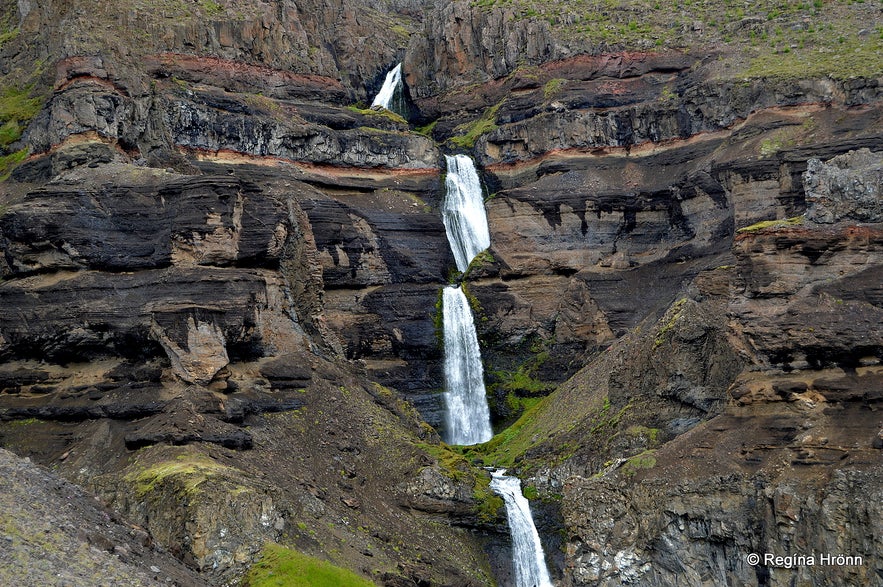 Bólugil gorge and the waterfalls
Bólugil gorge and the waterfalls
Here is the location of Bólugil gorge on Google maps.
If you are looking for activities in this area other than hiking then it is possible to go river rafting on the glacial rivers Austari-Jökulsá and Vestari-Jökulsá.
Have a lovely time in North Iceland :)
Ref.:
Saga af Grími Skeljungsbana - Þjóðsögur Jóns Árnasonar volume I, (pages 237-238)
Þáttur af Grími Skeljungsbana - Þjóðsögur Jóns Árnasonar volume I, (pages 238-246)
Silfrúnarstaðaskeljungur - Þjóðsögur Jóns Árnasonar volume III, (pages 318-320)
Kirkjur Íslands - Silfrastaðakirkja volume 5
Otros blogs interesantes
Chasing Waterfalls in Iceland
Iceland is spectacular in so many ways and Icelandic nature is quite unique with its vast landscape, volcanic activity, geothermal areas, glacier lagoons and sceneries, black sand beaches and spectLeer másSænautasel Turf House in the Highland of Iceland
In my search for turf houses around Iceland, I visited Sænautasel, which is a rebuilt turf house on Jökuldalsheiði heath in the highland of Iceland. It is, in my opinion, an extremely cute turf hoLeer másThe Dynamic Plant Lupine
People have been asking me where to find lupines in Iceland. If you like them you should be able to find them easily in Iceland in summer. They are in bloom and visible almost wherever you drive aroLeer más

Descarga la mayor plataforma de viajes a Islandia en tu móvil para gestionar tu viaje al completo desde un solo sitio
Escanea este código QR con la cámara de tu móvil y pulsa en el enlace que aparece para añadir la mayor plataforma de viajes a Islandia a tu bolsillo. Indica tu número de teléfono o dirección de correo electrónico para recibir un SMS o correo electrónico con el enlace de descarga.















